Five kinds of game crafting systems
In recent years, crafting has evolved from the rarely applicable mechanics of role-playing games to the almost universal addition to all the latest industry innovations. Today, it is used not only in almost any RPG, but also in first-person shooters, action games, driving simulators, and even in the icon assignment system for Steam users.
Apparently, there is something attractive in the process of processing basic resources into useful items, and players are happy to accept the strategy and choice provided by this mechanics. But, despite the widespread use of crafting systems, there are a number of significant differences in their design and implementation. In this article I tried to break down these systems into five conditional categories, emphasize their strengths and weaknesses, and also briefly outline the optimal use.

')
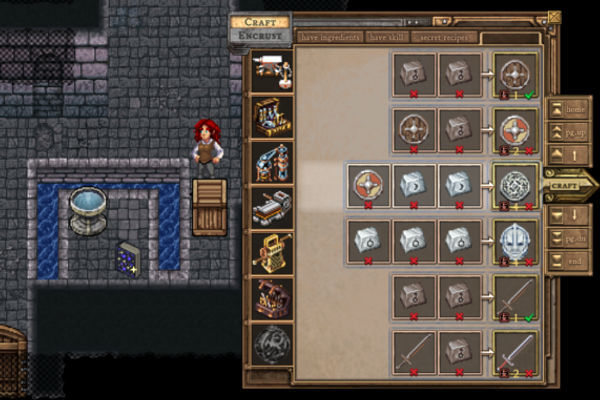
Dungeons of Dredmor Crafting
Used in Dragon Age: Origins, The Elder Scrolls V: Skyrim (Blacksmithing), The Legend of Zelda: Skyward Sword, XCOM: Enemy Unknown, Assassin's Creed III, Terraria, Dungeons of Dredmor, Kingdom of Loathing, Bioshock, etc.
This is the most common version of game crafting, although, in fact, it is such only in a conceptual sense. In this case, the player pays for the required item or update with the collected resources, and the exchange takes place under a fixed and transparent scenario. Thus, it is not crafting in the literal sense, but only an abstraction: you take a certain amount of wood, go to an artisan or to a machine tool - and in the end you get a wooden shield.
In principle, this system is inseparable from the main in-game economy, but instead of using some thematic monetary resource like gold coins, we use thematic raw materials, such as iron bars, logs, or wolf skins.
Benefits
Due to its simplicity, this type of crafting is intuitive and instantly perceived. The costs and results of production within such a system are clearly defined, because the player needs a minimum of explanation or is not required at all. Since this type of crafting works at the expense of existing game systems, it is very easy to implement, especially if the same interface is suitable for it as for ordinary trading. It is also an effective way to give the game economy additional depth, since the very idea of turning raw materials into finished products is much richer than simply buying them for money.
Among other things, this system will help balance the game, giving additional control over the resources that are available to the player. By making any resource necessary for sharing more rare or opening access to it only at a certain stage, the designer is able to mask the true value of the items. Suppose the game has a cool sword for 1000 gold. The player can either long and diligently collect on him, or even abandon the expensive purchase. But if the cost of the sword will be, say, 50 steel bars, it may seem that it is much easier to save for it, even if it takes no less effort than to collect 1,000 gold.
disadvantages
The main drawback of the system is its simplicity. As a rule, the capabilities of such a system are not quite enough for games designed for deep immersion. In this case, it is also difficult to maintain the right balance between a small but neat addition and a bulky and taut system. In addition, when using a large amount of resources, the system may become overly complex and tedious.
For example, the Assassin's Creed III crafting system has dozens of components. To create one unit of firearms, which except for sale is no good, you need a handle (made from maple wood), iron ore and flint (made from limestone, lead ore and iron ore). Such a number of small things quickly tires the player, especially if the reward for all efforts is rather modest.
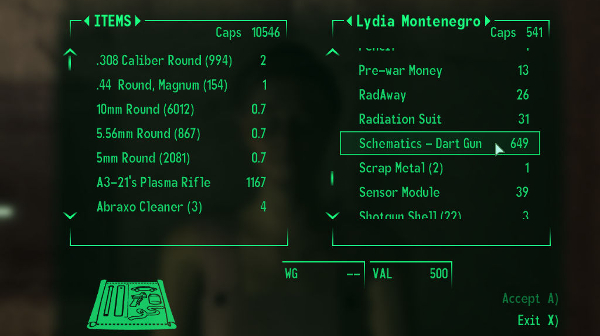
Recipe for Fallout 3
Used in Dragon Age: Inquisition, Diablo III, World of Warcraft, Dead Island, Fall Out 3 / New Vegas, The Witcher 2, Arcanum: Of Steamworks and Magick Obscura.
In this system, the creation of an object is not possible until a recipe, sketch, or drawing that opens the object is found. Such recipes can be found, purchased or given as a reward for completed tasks.
As soon as the player receives the desired recipe, the crafting process continues according to the same scenario as in the “Resources instead of money” model - through the established exchange of resources for the finished product. The difference is that here the player needs not only to have all the necessary resources for the exchange, but also to know that such an exchange is possible in principle. In rare cases, a recipe opens a new, more narrowly customizable form of crafting, as in Dragon Age: Inquisition.
Benefits
This system can give the crafting process an extra touch, because its idea is that it is not enough just to have the necessary resources, you also need to know how to combine them. In addition, by adding an extra step to the crafting process, you thereby increase the variety of awards provided to the player without increasing the total number of items. In addition, picking up the recipes and drawings themselves can be turned into exciting tasks.
It also supports intrigue in the game, since, unlike systems with monetary exchange, the player does not know in advance what items will open to him in the future. Finally, such a system gives the designer an additional restraining mechanism to limit players from getting access to certain content prematurely, even if it already has the necessary resources.
disadvantages
It is necessary to correctly balance the difficulty of extracting any recipe and the necessary resources with the value of the item produced as a result. If the reward for the item is insignificant, the entire system will be ignored in favor of other methods for obtaining items (purchase, robbery). On the other hand, if the reward is too good, all other methods of extraction can also be ousted.
As in the case of the “Resources instead of money” type, there is a risk of abuse of this system due to the simplicity of its implementation, as a result, collecting all the drawings can turn into routine work for the player. For example, in the game Dragon Age: Inquisition, there are about 200 sketches of armor and weapons, each of which is purchased or searched separately.
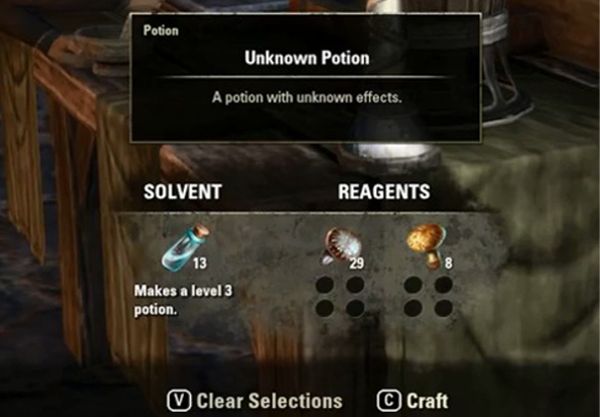
Create a potion in The Elder Scrolls Online
Used in Minecraft, Kingdoms of Amalur: Reckoning (Alchemy), The Secret World, The Elder Scrolls V: Skyrim (Alchemy), The Elder Scrolls Online (Alchemy) and Diablo II (Horadric Cube).
With this system, there are neither originally known crafting recipes, nor those that can be obtained. Instead, the player must independently open the recipes through trial and error. The user is provided with an interface for crafting, where you can combine and combine all the collected resources and components in order to obtain the desired result.
The complexity of such crafting can vary from simply choosing the right ingredients (as in Skyrim) to specifying their number or order of addition (as in Minecraft). This approach makes the resource combination system not an abstract mechanism for discovering new items, but literally a recipe that needs to be learned. Due to the ingredient-oriented nature of this system, it most often finds application in those games where crafting is expressed in the form of alchemy or culinary preparation.
Benefits
Unlike the two previous types, where the results of crafting are either known in advance or are available, this system gives the player a sense of real discovery. Instead of blindly sticking to specified instructions, the player can explore and improvise, revealing a wide variety of subjects.
And although in a sense, crafting here still remains an abstraction, the search for the right combinations brings the whole process closer to a real scientific experiment. Moreover, this type requires more involvement on the part of the player, which will help emphasize the merits of mechanics and its significance for the design of the game as a whole. Since all the resources available for experiments are limited, the game, as in the previous examples, will receive an additional restraining and balancing mechanism.
disadvantages
If the system punishes players too severely for unsuccessful attempts (for example, the consumption of rare resources), this may discourage further experiments. If the correct combinations of ingredients look too arbitrary, it may appear that the whole crafting process is not based on the study of properties, but rather on blind guessing. One way or another, in conditions of a too strict or complex system, the player will invariably tend to dishonest ways of finding the right answers. In this case, the system will resemble the “Resources instead of money” type, but with some disappointment for the player.
This type also risks becoming overly laborious (with the need to attract external resources) if the player has to remember too many recipes or if the correct answers are not stored in the game.
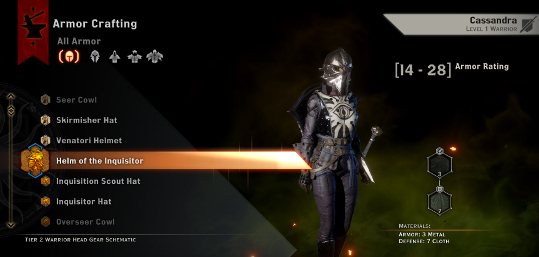
Armor creation in Dragon Age Inquisition
Used in Assassin's Creed: Revelations, Dragon Age: Inquisition, Dead Space 3, The Elder Scrolls V: Skyrim (Enchantment), The Elder Scrolls IV: Oblivion (Massaging Potions), Mass Effect 3, Monster Hunter Tri, Kingdoms of Amalur: Reckoning (Jewelcrafting) and Mercenary Kings.
This type can be attributed to any system with modular or dynamic crafting instead of creating objects strictly according to the formula or through the established exchange. In this case, the player can make an item to your taste, choosing a variety of options.
In Assassin's Creed: Revelations, players can produce bombs, and depending on the type of hull, fuse and ingredients for the filling chosen, various types of explosives are obtained with their purpose and effect. Unlike the previous type of crafting, where the player’s choice is limited to two possible development options — the correct and the wrong result, here the player can strategically choose from a number of known results. In fact, it may look like a choice of different materials, design elements, improvements, or even purely aesthetic additions to the subject.
Benefits
This type provides an in-depth user enhancement system that can truly reward players and provide static items or inventory with additional functionality. Since the player has a direct impact on the crafting product, there is more freedom of choice in this system than when buying or finding a new item. And if the available products have a clear application, as well as their advantages and disadvantages, all this can create an additional level of strategic choice within the game.
Improved flexibility and depth of this system will not only diversify the methods of creating objects, but will help to make the crafting process an integral part of the main game mechanics.
disadvantages
First of all, the increased complexity of the system compared with the above-mentioned types and the resulting difficulty of its implementation. Increased complexity, in addition, requires more attention from the player, which can greatly distract him from the main storyline if crafting is not a key element of the game. On the other hand, if you simplify the system, it will give a too small choice of options and its depth will take a superficial character. By providing a choice of only a few “correct” options, the system will negate the advantage of its use.
In general, if the amount of crafting products available is unsuccessful, you may have difficulty trying to establish in the game a balance between the created items and those that were obtained from other sources.
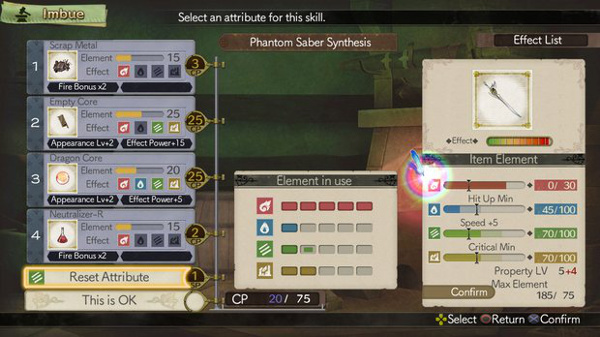
Alchemy in the game Atelier Escha Logy Alchemists of the Dusk Sky
Used in Vagrant Story, The Legend of Mana, Treasure of the Rudra (Kotodama), Breath of Fire III (Dragon Genes), the Atelier Series and The Elder Scrolls III: Morrowind (Creating Spells).
This is a broad category to which any real crafting system belongs, where various input components can produce a whole host of possible outcomes. The result is a truly dynamic process with a broad strategic choice. For example, the system of combining the blade and handle in the game Vagrant Story allows you to create thousands of weapons. Under such circumstances, crafting can become the main mechanics of the game, as in the Atelier series of the JRPG genre. Usually, the “Everything is possible” system becomes the only source for obtaining items in games where it is represented, because otherwise it would be difficult to maintain a balance between the created items and those that are easier to reach in other ways.
For a full study of systems of similar complexity, players may need a lot of time. For example, in the game The Legend of Mana, the crafting system is so extensive (and at the same time barely described in the game) that even 15 years after the release, players continue to discover useful recipes.
Benefits
This system can incredibly reward the most persistent researchers. Having such a number of dynamic capabilities, the user can have a significant impact on the gameplay. The depth of such systems will significantly improve the gameplay or increase replayability. In turn, the difficulty of calculating all the possible outcomes of crafting will help the game resist optimization and stagnant gameplay.
Perhaps this is the least abstract form of crafting, since the infinite variety of the system allows you to create many valuable items, and the ability to test them with further improvements distinguishes this mechanics from simple scientific experiments, as in the “Improvisation Only” system.
disadvantages
Such systems with their depth and variety are extremely difficult to think out and implement, since they require much more planning and tests. In addition, their complexity will be inappropriate for most games, where crafting acts, rather, in the role of additional mechanics, and not the main feature.
Since such systems often offer an unlimited number of possible results, there is a high likelihood of the emergence of super-powerful combinations of ingredients (giving too good items) that you, as a developer, will not be easy to identify in advance.
Conclusion
Crafting can serve for many purposes in the game. Due to the variety of forms, it gives the player rich opportunities to create objects in different settings, be it forging armor in a fantasy game or a high-tech modification of the weapon in a game of the genre sci-fi. Crafting can also play a key regulatory role in the in-game upgrade system, while being a more elegant solution than the less disguised restrictions. Moreover, with sufficient depth, this mechanic is capable of giving the gameplay a strategic bias.
Anyway, crafting is not suitable for any game. If implemented incorrectly, it will become inappropriate and distracting appendage of the game, and if at the same time to make it unnecessarily difficult, the game risks becoming boring and depressing. Crafting systems are structural mechanics, and therefore they bring the best result when used to support the original goals of game development.
Apparently, there is something attractive in the process of processing basic resources into useful items, and players are happy to accept the strategy and choice provided by this mechanics. But, despite the widespread use of crafting systems, there are a number of significant differences in their design and implementation. In this article I tried to break down these systems into five conditional categories, emphasize their strengths and weaknesses, and also briefly outline the optimal use.

Type 1: "Resources instead of money"
')

Dungeons of Dredmor Crafting
Used in Dragon Age: Origins, The Elder Scrolls V: Skyrim (Blacksmithing), The Legend of Zelda: Skyward Sword, XCOM: Enemy Unknown, Assassin's Creed III, Terraria, Dungeons of Dredmor, Kingdom of Loathing, Bioshock, etc.
This is the most common version of game crafting, although, in fact, it is such only in a conceptual sense. In this case, the player pays for the required item or update with the collected resources, and the exchange takes place under a fixed and transparent scenario. Thus, it is not crafting in the literal sense, but only an abstraction: you take a certain amount of wood, go to an artisan or to a machine tool - and in the end you get a wooden shield.
In principle, this system is inseparable from the main in-game economy, but instead of using some thematic monetary resource like gold coins, we use thematic raw materials, such as iron bars, logs, or wolf skins.
Benefits
Due to its simplicity, this type of crafting is intuitive and instantly perceived. The costs and results of production within such a system are clearly defined, because the player needs a minimum of explanation or is not required at all. Since this type of crafting works at the expense of existing game systems, it is very easy to implement, especially if the same interface is suitable for it as for ordinary trading. It is also an effective way to give the game economy additional depth, since the very idea of turning raw materials into finished products is much richer than simply buying them for money.
Among other things, this system will help balance the game, giving additional control over the resources that are available to the player. By making any resource necessary for sharing more rare or opening access to it only at a certain stage, the designer is able to mask the true value of the items. Suppose the game has a cool sword for 1000 gold. The player can either long and diligently collect on him, or even abandon the expensive purchase. But if the cost of the sword will be, say, 50 steel bars, it may seem that it is much easier to save for it, even if it takes no less effort than to collect 1,000 gold.
disadvantages
The main drawback of the system is its simplicity. As a rule, the capabilities of such a system are not quite enough for games designed for deep immersion. In this case, it is also difficult to maintain the right balance between a small but neat addition and a bulky and taut system. In addition, when using a large amount of resources, the system may become overly complex and tedious.
For example, the Assassin's Creed III crafting system has dozens of components. To create one unit of firearms, which except for sale is no good, you need a handle (made from maple wood), iron ore and flint (made from limestone, lead ore and iron ore). Such a number of small things quickly tires the player, especially if the reward for all efforts is rather modest.
Type 2: “Find the recipe”

Recipe for Fallout 3
Used in Dragon Age: Inquisition, Diablo III, World of Warcraft, Dead Island, Fall Out 3 / New Vegas, The Witcher 2, Arcanum: Of Steamworks and Magick Obscura.
In this system, the creation of an object is not possible until a recipe, sketch, or drawing that opens the object is found. Such recipes can be found, purchased or given as a reward for completed tasks.
As soon as the player receives the desired recipe, the crafting process continues according to the same scenario as in the “Resources instead of money” model - through the established exchange of resources for the finished product. The difference is that here the player needs not only to have all the necessary resources for the exchange, but also to know that such an exchange is possible in principle. In rare cases, a recipe opens a new, more narrowly customizable form of crafting, as in Dragon Age: Inquisition.
Benefits
This system can give the crafting process an extra touch, because its idea is that it is not enough just to have the necessary resources, you also need to know how to combine them. In addition, by adding an extra step to the crafting process, you thereby increase the variety of awards provided to the player without increasing the total number of items. In addition, picking up the recipes and drawings themselves can be turned into exciting tasks.
It also supports intrigue in the game, since, unlike systems with monetary exchange, the player does not know in advance what items will open to him in the future. Finally, such a system gives the designer an additional restraining mechanism to limit players from getting access to certain content prematurely, even if it already has the necessary resources.
disadvantages
It is necessary to correctly balance the difficulty of extracting any recipe and the necessary resources with the value of the item produced as a result. If the reward for the item is insignificant, the entire system will be ignored in favor of other methods for obtaining items (purchase, robbery). On the other hand, if the reward is too good, all other methods of extraction can also be ousted.
As in the case of the “Resources instead of money” type, there is a risk of abuse of this system due to the simplicity of its implementation, as a result, collecting all the drawings can turn into routine work for the player. For example, in the game Dragon Age: Inquisition, there are about 200 sketches of armor and weapons, each of which is purchased or searched separately.
Type 3: Improvisation Only

Create a potion in The Elder Scrolls Online
Used in Minecraft, Kingdoms of Amalur: Reckoning (Alchemy), The Secret World, The Elder Scrolls V: Skyrim (Alchemy), The Elder Scrolls Online (Alchemy) and Diablo II (Horadric Cube).
With this system, there are neither originally known crafting recipes, nor those that can be obtained. Instead, the player must independently open the recipes through trial and error. The user is provided with an interface for crafting, where you can combine and combine all the collected resources and components in order to obtain the desired result.
The complexity of such crafting can vary from simply choosing the right ingredients (as in Skyrim) to specifying their number or order of addition (as in Minecraft). This approach makes the resource combination system not an abstract mechanism for discovering new items, but literally a recipe that needs to be learned. Due to the ingredient-oriented nature of this system, it most often finds application in those games where crafting is expressed in the form of alchemy or culinary preparation.
Benefits
Unlike the two previous types, where the results of crafting are either known in advance or are available, this system gives the player a sense of real discovery. Instead of blindly sticking to specified instructions, the player can explore and improvise, revealing a wide variety of subjects.
And although in a sense, crafting here still remains an abstraction, the search for the right combinations brings the whole process closer to a real scientific experiment. Moreover, this type requires more involvement on the part of the player, which will help emphasize the merits of mechanics and its significance for the design of the game as a whole. Since all the resources available for experiments are limited, the game, as in the previous examples, will receive an additional restraining and balancing mechanism.
disadvantages
If the system punishes players too severely for unsuccessful attempts (for example, the consumption of rare resources), this may discourage further experiments. If the correct combinations of ingredients look too arbitrary, it may appear that the whole crafting process is not based on the study of properties, but rather on blind guessing. One way or another, in conditions of a too strict or complex system, the player will invariably tend to dishonest ways of finding the right answers. In this case, the system will resemble the “Resources instead of money” type, but with some disappointment for the player.
This type also risks becoming overly laborious (with the need to attract external resources) if the player has to remember too many recipes or if the correct answers are not stored in the game.
Type 4: "Improvements to your taste"

Armor creation in Dragon Age Inquisition
Used in Assassin's Creed: Revelations, Dragon Age: Inquisition, Dead Space 3, The Elder Scrolls V: Skyrim (Enchantment), The Elder Scrolls IV: Oblivion (Massaging Potions), Mass Effect 3, Monster Hunter Tri, Kingdoms of Amalur: Reckoning (Jewelcrafting) and Mercenary Kings.
This type can be attributed to any system with modular or dynamic crafting instead of creating objects strictly according to the formula or through the established exchange. In this case, the player can make an item to your taste, choosing a variety of options.
In Assassin's Creed: Revelations, players can produce bombs, and depending on the type of hull, fuse and ingredients for the filling chosen, various types of explosives are obtained with their purpose and effect. Unlike the previous type of crafting, where the player’s choice is limited to two possible development options — the correct and the wrong result, here the player can strategically choose from a number of known results. In fact, it may look like a choice of different materials, design elements, improvements, or even purely aesthetic additions to the subject.
Benefits
This type provides an in-depth user enhancement system that can truly reward players and provide static items or inventory with additional functionality. Since the player has a direct impact on the crafting product, there is more freedom of choice in this system than when buying or finding a new item. And if the available products have a clear application, as well as their advantages and disadvantages, all this can create an additional level of strategic choice within the game.
Improved flexibility and depth of this system will not only diversify the methods of creating objects, but will help to make the crafting process an integral part of the main game mechanics.
disadvantages
First of all, the increased complexity of the system compared with the above-mentioned types and the resulting difficulty of its implementation. Increased complexity, in addition, requires more attention from the player, which can greatly distract him from the main storyline if crafting is not a key element of the game. On the other hand, if you simplify the system, it will give a too small choice of options and its depth will take a superficial character. By providing a choice of only a few “correct” options, the system will negate the advantage of its use.
In general, if the amount of crafting products available is unsuccessful, you may have difficulty trying to establish in the game a balance between the created items and those that were obtained from other sources.
Type 5: "Everything is possible"

Alchemy in the game Atelier Escha Logy Alchemists of the Dusk Sky
Used in Vagrant Story, The Legend of Mana, Treasure of the Rudra (Kotodama), Breath of Fire III (Dragon Genes), the Atelier Series and The Elder Scrolls III: Morrowind (Creating Spells).
This is a broad category to which any real crafting system belongs, where various input components can produce a whole host of possible outcomes. The result is a truly dynamic process with a broad strategic choice. For example, the system of combining the blade and handle in the game Vagrant Story allows you to create thousands of weapons. Under such circumstances, crafting can become the main mechanics of the game, as in the Atelier series of the JRPG genre. Usually, the “Everything is possible” system becomes the only source for obtaining items in games where it is represented, because otherwise it would be difficult to maintain a balance between the created items and those that are easier to reach in other ways.
For a full study of systems of similar complexity, players may need a lot of time. For example, in the game The Legend of Mana, the crafting system is so extensive (and at the same time barely described in the game) that even 15 years after the release, players continue to discover useful recipes.
Benefits
This system can incredibly reward the most persistent researchers. Having such a number of dynamic capabilities, the user can have a significant impact on the gameplay. The depth of such systems will significantly improve the gameplay or increase replayability. In turn, the difficulty of calculating all the possible outcomes of crafting will help the game resist optimization and stagnant gameplay.
Perhaps this is the least abstract form of crafting, since the infinite variety of the system allows you to create many valuable items, and the ability to test them with further improvements distinguishes this mechanics from simple scientific experiments, as in the “Improvisation Only” system.
disadvantages
Such systems with their depth and variety are extremely difficult to think out and implement, since they require much more planning and tests. In addition, their complexity will be inappropriate for most games, where crafting acts, rather, in the role of additional mechanics, and not the main feature.
Since such systems often offer an unlimited number of possible results, there is a high likelihood of the emergence of super-powerful combinations of ingredients (giving too good items) that you, as a developer, will not be easy to identify in advance.
Conclusion
Crafting can serve for many purposes in the game. Due to the variety of forms, it gives the player rich opportunities to create objects in different settings, be it forging armor in a fantasy game or a high-tech modification of the weapon in a game of the genre sci-fi. Crafting can also play a key regulatory role in the in-game upgrade system, while being a more elegant solution than the less disguised restrictions. Moreover, with sufficient depth, this mechanic is capable of giving the gameplay a strategic bias.
Anyway, crafting is not suitable for any game. If implemented incorrectly, it will become inappropriate and distracting appendage of the game, and if at the same time to make it unnecessarily difficult, the game risks becoming boring and depressing. Crafting systems are structural mechanics, and therefore they bring the best result when used to support the original goals of game development.
Source: https://habr.com/ru/post/309854/
All Articles